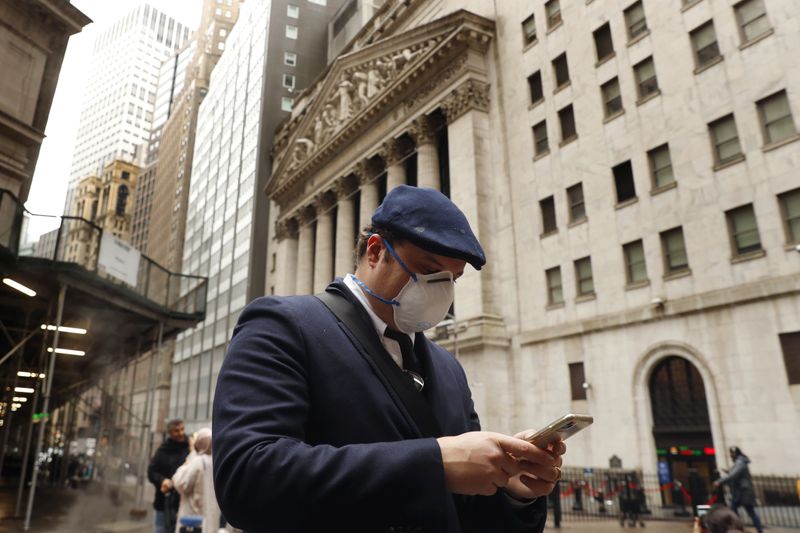
Dow Jones Industrial Average futures alternated between gains and losses on Wednesday as results of the presidential contest so far failed to yield a clear winner on election night, disappointing investors who wanted a certain outcome.
Dow futures traded 73 points lower, or 0.2%. Overnight, those contracts were up more than 1%. S&P 500 futures gained 0.5%. Futures for the Nasdaq 100, home to the big mega-cap tech stocks, rose 2.5% as investors crowded back into the trade that’s been working for most of this tumultuous year.
Earlier in the overnight session, futures contracts for the Dow and S&P 500 came under some pressure after President Donald Trump tried to claim victory even though millions of legitimate votes were not yet counted.
“We were getting ready for a big celebration. We were winning everything, and all of a sudden it was just called off,” Trump said. “We’ll be going to the U.S. Supreme Court, we want all voting to stop.”
“We don’t want them to find any ballots at 4 o’clock in the morning and add them to the list,” he added.
Democratic nominee Joe Biden appeared to be unable to take North Carolina, with Trump holding a lead in that state, according to NBC News. However, Biden was leading in Arizona, although NBC News said it was too early to call the state. Key swing states Michigan, Wisconsin and Pennsylvania could take days to determine.
“We believe we’re on track to win this election,” Biden said to supporters in Delaware overnight. The candidate said the winner could be known Wednesday morning but it could take a little longer.
Trump is projected to win the presidential vote in Florida, Indiana and Kentucky along with South Dakota, Arkansas and Ohio, NBC News said. Trump is also projected to win Alabama and North Dakota. Biden is projected to win Vermont, Delaware, Maryland and Massachusetts as well as Colorado, New York and Virginia, according to NBC News.
“We’re seeing in one night what we’ve seen over the past two weeks, which is a tug of war within the polling itself causing wide swings in the market as uncertainty persists,” said Keith Lerner, chief market strategist at Truist/SunTrust Advisory.
Shares of major tech-related companies jumped in early premarket trading. Facebook, Amazon, Apple, Alphabet and Microsoft were all up more than 2%. Netflix traded 1.5% higher.
Wall Street traders and investors attributed the move in tech and the Nasdaq 100 futures to a number of factors, including the group’s consistently solid returns. Additionally, some viewed a potentially split Congress as a positive for the group since a higher capital gains tax could have weighed on the sector.
Contested election?
Other financial markets markets were gyrating overnight as results came in:
- Bonds reversed higher, with the yield on the 10-year Treasury note falling to 0.798%. (Yields move inversely to prices.)
- Futures for the small-cap benchmark Russell 2000 dropped 2.8% after rising earlier.
- The U.S. dollar index gained 0.5%.
Traders also grappled with the possibility of a contested election result, which Wall Street strategists say could have major consequences for the stock market. Among other things, analysts warn that a delayed result would hamper the ability of Washington to pass additional fiscal stimulus amid a jump in Covid-19 cases.
Wall Street was coming off a strong session on Tuesday, with the Dow jumping more than 500 points. The S&P 500 and Nasdaq Composite, meanwhile, jumped more than 1% each.
Those moves came as investors hoped a delayed, or contested, U.S. presidential election result would be avoided and a clear winner would emerge Tuesday night. Biden was ahead of Trump in the polls leading up to Tuesday.
Senate battle
Traders were also eyeing the battle for the Senate and its implications for future fiscal policies. So far on election night, it was unclear whether the Democrats would be able to win back the Senate. Republicans possibly gained a key win with Republican Sen. Joni Ernst projected to win the Iowa Senate race.
Going into the election, traders feared a Democrat win in the Senate and a Biden presidency could bring higher tax rates, impacting technology shares especially. At the same time, some investors were hopeful that a so-called blue wave could yield a bigger stimulus to battle the effects of the coronavirus, boosting stocks linked to the broader economy.
The S&P 500 lost 0.4%, on average, the day after presidential elections, according to Baird.
Chao Ma of the Wells Fargo Investment Institute thinks investors with a longer time horizon should not worry too much about the election’s impact on the broader market.
“The history of the economy and the S&P 500 Index suggests that a president’s party affiliation has made little difference when it comes to long-term returns,” said the firm’s global portfolio and investment strategist. “The long-term drivers of the S&P 500 index have been the economy and business earnings, and we expect that to continue to be the case … beyond the 2020 elections.”
One year out from a presidential election, the S&P 500 averaged a return of more than 8%, according to the Baird data back to 1960.
“When this is all said and done, I still believe equities will move higher regardless of who wins the Oval Office,” said Ryan Nauman, market strategist at Informa Financial intelligence, noting the coronavirus pandemic and U.S. monetary policy will be bigger market drivers over the long haul.
—CNBC’s Pippa Stevens contributed to this report.
Subscribe to CNBC PRO for exclusive insights and analysis, and live business day programming from around the world.

